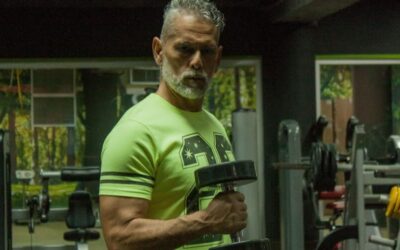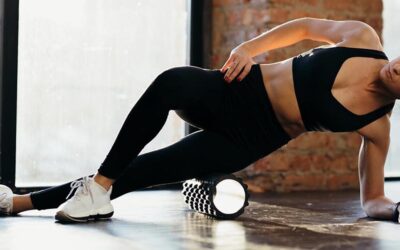Why does the astronaut run on a treadmill in space?
No, it’s not the set-up to a hilarious joke – this astronaut is preventing sarcopenia. Sarcopenia, also known as muscle atrophy, is the wasting or loss of muscle tissue. In space, the lack of gravity accelerates muscle atrophy because there is no gravitational resistance to keep muscles toned.
But you don’t have to live in space to experience muscle atrophy – older San Diegans who chose to live sedentary lives can experience similar effects. Thankfully, our bodies are constantly fighting gravity, which provides resistance equal to the effort we expend. It means we don’t have to run a 5k each day just to keep the muscles we have, but we do need to get up and get moving. There is clear evidence that resistance exercise helps protect muscle mass, even if you are temporarily bed-ridden or recovering from an injury or surgery.
When we age, we are prone to becoming inert. Our joints become swollen, arthritis starts to take its toll, old injuries act up, illness and other medical maladies affect our level of energy. And since most older Americans are delaying retirement, we are no longer as free as we once were to pursue active hobbies. When we spend our evenings commuting – either sitting behind the wheel or shoulder-to-shoulder on mass transit – we’re sacrificing that sunset walk, that bike ride on our favorite trail, or that swim class at the Y. And that could lead to significantly reduced muscle quality and strength, which will lead to a lower quality of life.
Everyone knows that exercise is good for us. But not all exercise is good for all of us.
Let’s break down that thought. A 60-year-old person who routinely runs 5k races has a different level of fitness than the 40-year-old person who pauses for breath while walking up the steps (medical conditions aside). Age doesn’t matter here; what matters is that the older person is keeping their muscles active and strong while the younger person isn’t. The workout routine of the 60-year-old would not be ideal for the 40-year-old in this scenario. So let’s use this 40-year-old person’s level of fitness to illustrate what kind of physical activity is necessary to go from sedentary to strong.
Moving Away From Inactivity
The CDC recommends only 5-10 minutes a day of moderate physical activity for people who are generally inactive or who have no recent experience exercising. If this seems short to you, that’s because the goal is simply to rev up your engine without causing an unnecessary injury. If your muscles are primarily used to stand up, walk from room to room, and lift groceries, the fibers in those muscles aren’t prepared to endure much more. By starting with 10 minutes of moderate exercise, you’re gradually building strength and agility without pushing your muscles too far beyond their limit.
Moderate physical activity can include walking, climbing stairs, or even mowing the lawn (with a push mower, not a riding mower). That’s right – chores count. There are lots of ways you can get an extra bit of exercise throughout your day without having to go to the gym.
Adding Exercise to Your Everyday
Try these simple ways to infuse exercise into your everyday activities:
Walk the Dog
Hopefully if you have a canine boarder in your home, you’re already doing this. But instead of ending your walks after the business is done, keep going. Your dog could use the exercise too – muscle atrophy doesn’t just occur in humans.
Park Far Away
If you’re one of those people who circles the parking lot at the grocery store in search of the closest possible space, you’re doing yourself a disservice. Park at the back end of the parking lot and get those extra steps. If this sounds pointless to you, consider this: walking speed is a huge factor in determining your quality of life – and your gait may even help predict how long you have to live. So get to steppin’!
Take the Stairs
We’re not recommending that you walk to the top of One America Plaza just for the sake of taking the stairs, we do recommend skipping that elevator ride to the third floor. Stairs are not only a great way to build strength in your hips and legs, but walking stairs can help build your aerobic capacity, too.
TV Yoga
How many hours each day do you spend in front of the TV? Try making those hours count for something else by doing simple yoga poses while you watch your favorite stories. Stretching and posing, especially with light resistance bands, can be a terrific way to increase your mobility, agility, and strength during a time when you’d otherwise be sedentary.
By talking to a healthcare professional or physical therapist, you can together craft a plan that fits your schedule and your abilities.
For More Information
Unfortunately, sarcopenia isn’t the only condition that can affect the muscle strength and tone of older people. There are a number of genetic diseases that affect muscle mass (ALS, Guillain-Barre Syndrome, etc), but these are not a result of a sedentary lifestyle and are often out of your control. If you are interested in learning more about muscular dystrophy, go here for more information from the Mayo Clinic.
Relevant Sources for Aging and Muscle Atrophy
- https://medlineplus.gov/ency/article/003188.htm
- https://www.cbsnews.com/news/why-are-americans-putting-off-retirement/
- https://www.ncbi.nlm.nih.gov/pmc/articles/PMC4066461/
- https://www.cdc.gov/nccdphp/sgr/olderad.htm
- https://www.ncbi.nlm.nih.gov/pmc/articles/PMC3276215/
- https://jamanetwork.com/journals/jama/fullarticle/644554
- https://www.mayoclinic.org/diseases-conditions/muscular-dystrophy/symptoms-causes/syc-20375388


